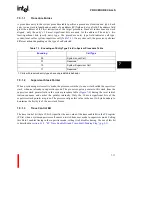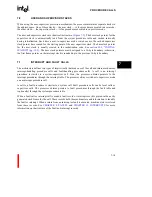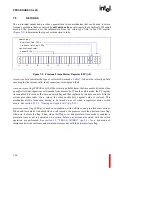
FAULTS
8-4
In
Table 8-1
:
•
The first (left-most) column contains the fault type numbers in hexadecimal.
•
The second column shows the fault type name.
•
The third column gives the fault subtype number as either: (1) a hexadecimal number or (2) as
a bit position in the fault record’s 8-bit fault subtype field. The bit position method of
indicating a fault subtype is used for certain faults (such as trace faults) in which two or more
fault subtypes may occur simultaneously.
•
The fourth column gives the fault subtype name. For convenience, individual faults are
referenced by their fault-subtype names. Thus an OPERATION.INVALID_OPERAND fault
is referred to as an INVALID_OPERAND fault; an ARITHMETIC.INTEGER_OVERFLOW
fault is referred to as an INTEGER_OVERFLOW fault.
•
The fifth column shows the encoding of the word in the fault record that contains the fault
type and fault subtype numbers.
Other i960 processor family members may provide extensions that recognize additional fault
conditions. Fault type and subtype encoding allows all faults to be included in the fault table: those
that are common to all i960 processors and those that are specific to one or more family members.
The fault types are used consistently for all family members. For example, Fault Type 4H is
reserved for floating point faults. Any i960 processor with floating point operations uses Entry 4H
to store the pointer to the floating point fault handling procedure.
8.3
FAULT TABLE
The fault table (
Figure 8-2
) is the processor’s pathway to the fault handling procedures. It can be
located anywhere in the address space. From the process control block, the processor obtains a
pointer to the fault table during initialization.
The fault table contains one entry for each fault type. When a fault occurs, the processor uses the
fault type to select an entry in the fault table. From this entry, the processor obtains a pointer to the
fault handling procedure for the type of fault that occurred. Once called, a fault handling procedure
has the option of reading the fault subtype or subtypes from the fault record when determining the
appropriate fault recovery action.
Summary of Contents for i960 Jx
Page 1: ...Release Date December 1997 Order Number 272483 002 i960 Jx Microprocessor Developer s Manual ...
Page 24: ......
Page 25: ...1 INTRODUCTION ...
Page 26: ......
Page 35: ...2 DATA TYPES AND MEMORY ADDRESSING MODES ...
Page 36: ......
Page 46: ......
Page 47: ...3 PROGRAMMING ENVIRONMENT ...
Page 48: ......
Page 73: ...4 CACHE AND ON CHIP DATA RAM ...
Page 74: ......
Page 85: ...5 INSTRUCTION SET OVERVIEW ...
Page 86: ......
Page 111: ...6 INSTRUCTION SET REFERENCE ...
Page 112: ......
Page 233: ...7 PROCEDURE CALLS ...
Page 234: ......
Page 256: ......
Page 257: ...8 FAULTS ...
Page 258: ......
Page 291: ...9 TRACING AND DEBUGGING ...
Page 292: ......
Page 309: ...10 TIMERS ...
Page 310: ......
Page 324: ......
Page 325: ...11 INTERRUPTS ...
Page 326: ......
Page 369: ...12 INITIALIZATION AND SYSTEM REQUIREMENTS ...
Page 370: ......
Page 412: ......
Page 413: ...13 MEMORY CONFIGURATION ...
Page 414: ......
Page 429: ...14 EXTERNAL BUS ...
Page 430: ......
Page 468: ......
Page 469: ...15 TEST FEATURES ...
Page 470: ......
Page 493: ...A CONSIDERATIONS FOR WRITING PORTABLE CODE ...
Page 494: ......
Page 502: ......
Page 503: ...B OPCODES AND EXECUTION TIMES ...
Page 504: ......
Page 515: ...C MACHINE LEVEL INSTRUCTION FORMATS ...
Page 516: ......
Page 523: ...D REGISTER AND DATA STRUCTURES ...
Page 524: ......
Page 550: ......
Page 551: ...GLOSSARY ...
Page 552: ......
Page 561: ...INDEX ...
Page 562: ......
Page 578: ......
















































